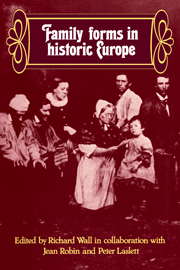Book contents
- Frontmatter
- Contents
- List of contributors
- Preface
- 1 Introduction
- 2 Two kinds of pre-industrial household formation system
- 3 ‘A large family: the peasant's greatest wealth’: serf households in Mishino, Russia, 1814–1858
- 4 The peasant family as an economic unit in the Polish feudal economy of the eighteenth century
- 5 The familial contexts of early childhood in Baltic serf society
- 6 Estonian households in the seventeenth and eighteenth centuries
- 7 Family and familia in early-medieval Bavaria
- 8 The property and kin relationships of retired farmers in northern and central Europe
- 9 Pre-industrial household structure in Hungary
- 10 The reconstruction of the family life course: theoretical problems and empirical results
- 11 The changing household: Austrian household structure from the seventeenth to the early twentieth century
- 12 Does owning real property influence the form of the household? An example from rural West Flanders
- 13 The evolving household: the case of Lampernisse, West Flanders
- 14 The composition of households in a population of 6 men to 10 women: south-east Bruges in 1814
- 15 The importance of women in an urban environment: the example of the Rheims household at the beginning of the Industrial Revolution
- 16 The household: demographic and economic change in England, 1650–1970
- 17 Family and household as work group and kin group: areas of traditional Europe compared
- References
- Index
1 - Introduction
Published online by Cambridge University Press: 05 November 2011
- Frontmatter
- Contents
- List of contributors
- Preface
- 1 Introduction
- 2 Two kinds of pre-industrial household formation system
- 3 ‘A large family: the peasant's greatest wealth’: serf households in Mishino, Russia, 1814–1858
- 4 The peasant family as an economic unit in the Polish feudal economy of the eighteenth century
- 5 The familial contexts of early childhood in Baltic serf society
- 6 Estonian households in the seventeenth and eighteenth centuries
- 7 Family and familia in early-medieval Bavaria
- 8 The property and kin relationships of retired farmers in northern and central Europe
- 9 Pre-industrial household structure in Hungary
- 10 The reconstruction of the family life course: theoretical problems and empirical results
- 11 The changing household: Austrian household structure from the seventeenth to the early twentieth century
- 12 Does owning real property influence the form of the household? An example from rural West Flanders
- 13 The evolving household: the case of Lampernisse, West Flanders
- 14 The composition of households in a population of 6 men to 10 women: south-east Bruges in 1814
- 15 The importance of women in an urban environment: the example of the Rheims household at the beginning of the Industrial Revolution
- 16 The household: demographic and economic change in England, 1650–1970
- 17 Family and household as work group and kin group: areas of traditional Europe compared
- References
- Index
Summary
Our initial approach to the subject of the household and family took its cue from prevailing expectations about the shape of the family in the past. It was almost inevitable that the discussion should focus on whether families were larger or smaller then than now, and in particular whether households were more or less likely to contain relatives beyond the immediate nuclear core of head, spouse, and unmarried child. Even so, Household and family in past time, when published in 1972, contained within it a great deal more than a simple statement about the predominance of the nuclear family in pre-industrial society, although the information on children, servants, and marital status is often by-passed by those eager to denounce, or defend, its major theme.
In the present volume it is our intention to look in more detail at all the constituent parts of the household and to place the household within the broad economic and social context. There is much more attention paid than was possible in 1972 to the life cycle of the household and to the influence of occupation on its structure. The questions that we have set ourselves include the following: What structure of the household is implied by a given inheritance pattern or work pattern? If we know the occupation or age of the head of the household, how much can legitimately be inferred about the overall composition of the household?
- Type
- Chapter
- Information
- Family Forms in Historic Europe , pp. 1 - 64Publisher: Cambridge University PressPrint publication year: 1983
- 16
- Cited by



